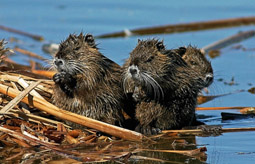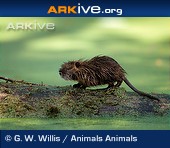Nutria
Nutria are also referred to as swamp beavers or beaver rats and belong to the family of the myocastoridae. These large rodents grow to a body length of 50 to 60 cm and gain a body weight of up to 14 kg. Because of their chubby form, nutria resemble beavers. Nutria are, however, somewhat smaller and do not have flat but round, rat-like tails. Originally from South America, these animals have been held on animal fur farms in many countries for years. The offspring of animals that fled or were freed from these farms spread, which is why nutria can be found in Asia, North America, as well as – sporadically – in Europe today.
The nutria’s natural habitat is preferably in regions close to water as well as densely wooded shores. They often live in groups of 10 to 15 animals, consisting of a grown male, related females, and their young. Young males often live alone. Depending on the size of the group, these young male often occupy and mark territories between 3 and 6 hectare in size. Nutria live in earthy caves that they dig themselves. They are primarily active at dusk and at night and feed on all kinds of plants. Nutria are exceptionally good swimmers thanks to their webbed hind feet. They spend their time feeding, taking care of each other’s fur, and swimming.
The females can have young two to three times a year. After 18 to 20 weeks, they bear an average of 3 to 6 young. It is, however, possible for a female to give birth to up to 13 young at the same time. The young are suckled for 8 weeks and gain weight quickly during this time. A particularity of the female nutria is the arrangement of her teat: they are not located on her belly but on her flank, allowing her to suckle her young even when in the water. Nutria are sexually mature at 6 months of age.
In addition to being held on farms, wild nutria are also caught in traps. To this purpose, nutria were settled in the warmer regions of the U.S. as well as in the former Soviet Union.


